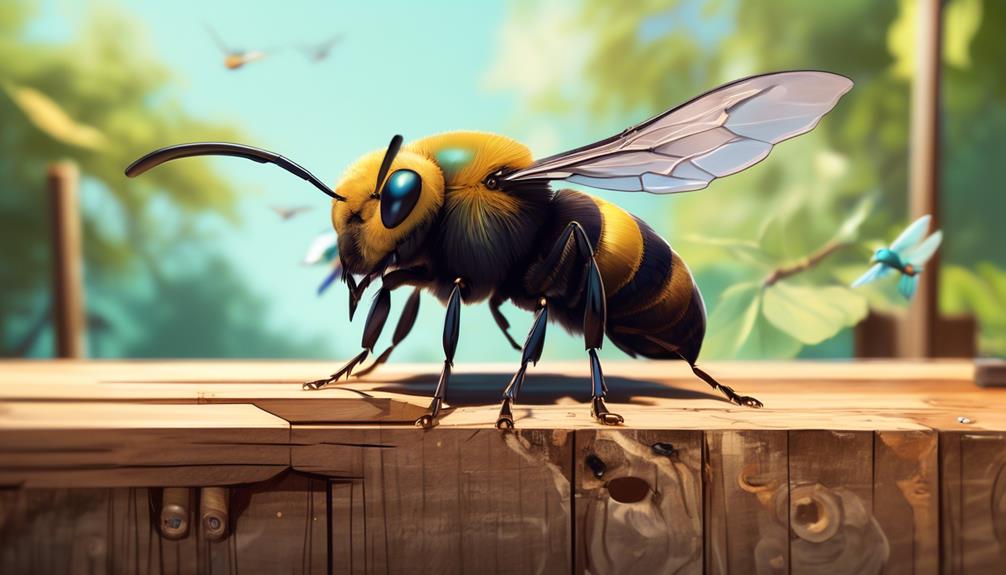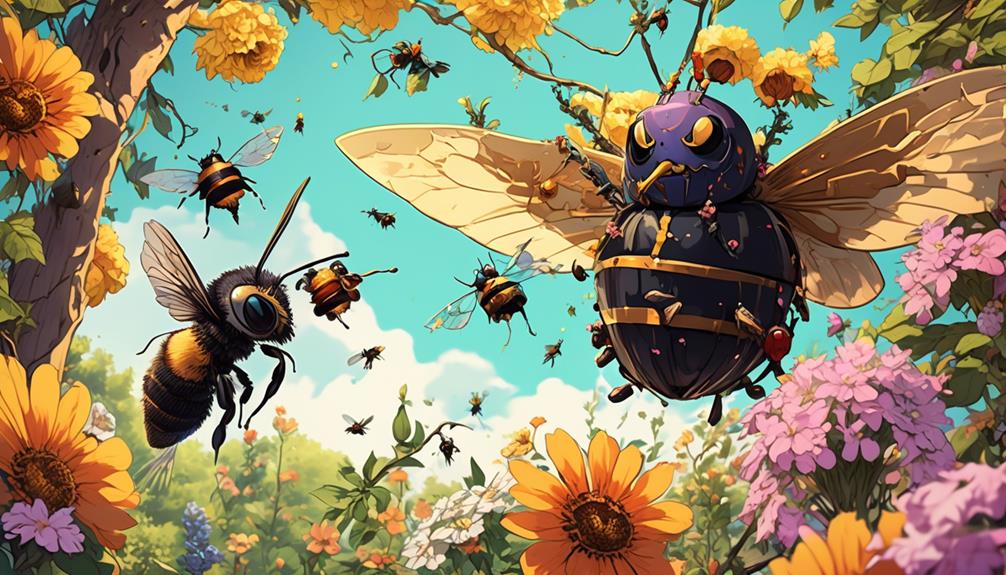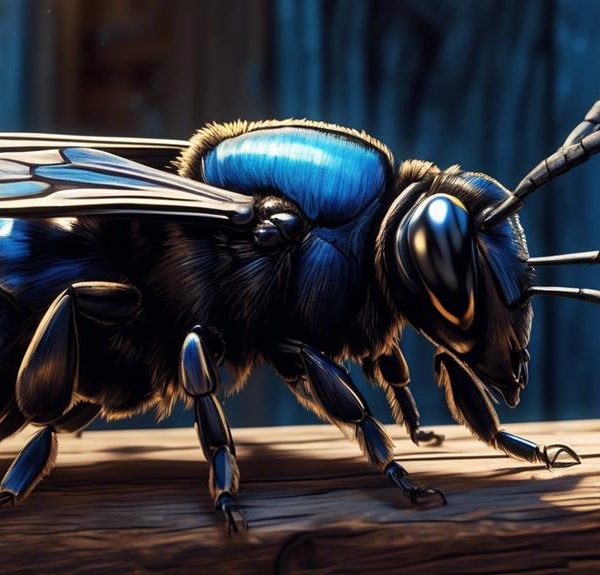Intriguing interactions between hummingbirds and carpenter bees may surprise you; discover whether these buzzing giants intimidate these delicate, iridescent birds.

Do Carpenter Bees Scare Away Hummingbirds
Picture yourself sitting in your garden on a warm sunny day, watching hummingbirds flit and dart around your blooming flowers, their iridescent feathers catching the light.
Suddenly, a large, buzzing carpenter bee joins the scene. You can't help but wonder, do these buzzing giants scare away the delicate hummingbirds?
While it's a known fact that the natural world is filled with fascinating interactions, the relationship between carpenter bees and hummingbirds is particularly interesting.
We'll explore this further, and you might be surprised by what you'll learn.
Key Takeaways
- Carpenter bees and hummingbirds both compete for the same nectar resources.
- Carpenter bees can significantly impact the frequency of hummingbird visits by monopolizing nectar sources and disturbing them with their buzzing sound.
- Hummingbirds may modify their feeding patterns to avoid carpenter bees, such as feeding early or late.
- To prevent carpenter bees invasion, treat wood with paint or varnish, opt for hardwoods for outdoor structures, regularly inspect and maintain wooden structures, use bee traps, and implement proper landscaping techniques.
Understanding Carpenter Bees

When you first encounter a carpenter bee, you'll notice its size and shiny, black abdomen, distinguishing it from other common bees. Unlike the fuzzy bumblebee, the carpenter bee's abdomen is devoid of hair, lending it a polished, dark appearance. The males, though unable to sting, are often more visible with their aggressive guarding of their territory.
Carpenter bees, scientifically known as Xylocopa, are large bees distributed worldwide. There are over 500 species, and they're named for their behavior of burrowing into hard plant material such as dead wood or bamboo. However, don't confuse them with termites, as they don't consume the wood but rather excavate tunnels for nesting sites.
If you're curious about their diet, they feed primarily on nectar and pollen, making them essential pollinators. Though they're solitary creatures, female carpenter bees might share their nests with their daughters or sisters, creating simple social groups.
Now that you've delved into the world of carpenter bees, you're better equipped to understand their behavior, their role in the ecosystem, and how they interact with other creatures, including hummingbirds.
Hummingbird's Natural Behavior

Just as with carpenter bees, understanding the natural behavior of hummingbirds requires a keen eye and a deep appreciation for their role in the ecosystem. These colorful creatures are known for their high-speed wing flapping and their ability to hover in mid-air. Their wings beat at an astonishing rate of 50 to 200 flaps per second, creating the humming sound from which they derive their name.
You'll note that hummingbirds are solitary and territorial, often defending their food sources from other birds. They're typically attracted to bright colors, especially red, which signals the presence of nectar. However, they don't rely solely on nectar for sustenance. They also consume small insects and spiders, providing essential proteins.
Hummingbirds are also known for their long-distance migration. Some species travel over 500 miles non-stop during these journeys. They have an exceptional memory and can remember every flower they've ever visited. They also exhibit a unique sleeping behavior called torpor, where they slow their heart rate to conserve energy.
Understanding these behaviors is crucial in assessing whether carpenter bees scare away hummingbirds. It's an analysis that involves careful observation and a genuine respect for these fascinating creatures.
Interaction Between Carpenter Bees and Hummingbirds

In observing the intricate dynamics of nature, you'll notice a complex interaction between carpenter bees and hummingbirds, each vying for the same nectar resources. While hummingbirds are swift and agile, carpenter bees are known for their robustness and tenacity. Despite their differences, they coexist in a shared ecosystem, often with competition over resources.
Let's consider their interaction in a more structured manner:
Behavior | Carpenter Bees | Hummingbirds |
|---|---|---|
Agility | Moderate | High |
Competition for Nectar | High | High |
Resource Defense | Moderate | High |
Adaptability to Change | High | Moderate |
From the table, you can see that while both species compete for the same resources, their strategies differ. Hummingbirds use their agility and resource defense to secure nectar, while carpenter bees rely on their robustness and adaptability to change.
This interaction, although seemingly adversarial, contributes to the balance of the ecosystem. It encourages each species to adapt and evolve, ensuring their survival. By understanding these interactions, you'll appreciate the delicate balance of nature's biodiversity.
Effect of Carpenter Bees on Hummingbirds Visits

You might observe that the presence of carpenter bees significantly impacts the frequency of hummingbird visits to a nectar source. If you're an avid bird watcher, you'll perhaps notice that the fluttering of these bees can create an intimidating environment for the delicate hummingbirds.
Carpenter bees, being relatively larger and more aggressive, tend to monopolize nectar sources. They aren't just after the nectar, they also cut into plant stems to lay their eggs. This activity can deter hummingbirds who are wary of these intruders.
Additionally, the buzzing sound produced by carpenter bees can be disturbing to hummingbirds. These tiny birds, known for their fast, darting movements, are sensitive to such noises. This noise, coupled with the bees' dominance over the feeder, could reduce the frequency of hummingbird visits.
Furthermore, scientific observations suggest that the presence of carpenter bees may lead hummingbirds to modify their feeding patterns. They might choose to feed early in the morning or late in the evening when carpenter bees are less active.
Tips to Prevent Carpenter Bees Invasion

Navigating the challenge of a carpenter bee invasion requires keen understanding and implementation of specific strategies to protect your hummingbird-friendly habitat. Understanding carpenter bee behaviors and preferences will direct you to effective intervention methods.
Carpenter bees are known for their preference of soft, untreated, and weathered wood. They're also solitary creatures that return to the same place year after year to nest. Use this knowledge to your advantage.
Here's a quick guide:
Strategy | Description |
|---|---|
Treat Wood | Carpenter bees prefer untreated wood. Use paint or varnish, especially oil-based, to deter them. |
Use Hard Woods | Opt for hardwoods for outdoor structures as bees prefer softwoods. |
Proper Maintenance | Regular inspection and maintenance of wooden structures can help detect early invasion. |
Use Bee Traps | Traps specifically designed for carpenter bees can be effective. Make sure to relocate the bees, not kill them. |
Conclusion
So, do carpenter bees scare away hummingbirds?
Yes, they do. These buzzing insects can deter your feathered friends from visiting your feeders.
But don't fret! By understanding their behavior and taking preventative measures, you can manage carpenter bees and keep your hummingbirds coming back.
Remember, it's all about creating a safe and welcoming environment for your avian visitors.
Keep observing, keep learning, and you'll cultivate a flourishing space for all your backyard guests.


